Dr.
Marianne Rozsondai:
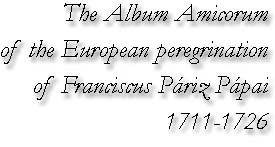
Library of the Hungarian Academy of
Sciences
Department of Manuscripts and Rare Books
Tört. Napló kis 8º 6
The albi amicorum of the students visiting various European
universities are not only interesting documents, but also important
sources of the cultural history of the European countries in the
Renaissance and the Baroque period. The fashion of the albi dates
back to the middle of the 16th century, to Melanchthon's Wittenberg,
but its roots can be traced back to the beginnings of the Renaissance.
In some countries it has survived for centuries, primarily amongst
Protestant students. In Germany such albi – called Stammbuch
– were widespread not only amongst young intellectuals, but also
amongst lower strata, like for example journeymen of various guilds.
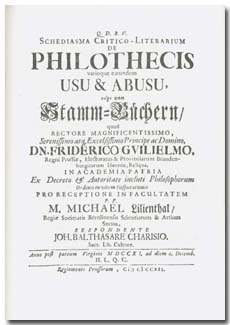 Genre and types of the album amicorum Genre and types of the album amicorum
We have used two terms for the genre: album and Stamm-
buch.
In international literature the term album amicorum
is the most
received, but it is sometimes also called
philotheca. A similar
term is written in ink in the inner front
endpaper of the album of
Ferenc Pápai Páriz Jr.: onomato-
phylacium (treasury of names).
This genre was extensively
treated in a book published in 1712 in
Königsberg, titled
Schediasma critico-literarium de
philothecis varioque earun-
dem usu et abusu,
vulgo von
Stamm-Büchern… Its author,
Michael
Lilienthal analyses the albi (or, as they are called in
his language, die Stammbücher) in terms of literary criticism,
with
respect to their types and uses. At the beginning of his
work he also
introduces the term philotheca, or in Greek

repositorium", that is, "thesaurus of friends".
The term "album" comes from Latin "white". In ancient Rome this was
the term for the white board used for advertising notices or sometimes
name lists. This is the origin of the album amicorum,
consisting of white pages and used for receiving autograms and
mementos of friends, fellow students, professors, as well as famous
personalities.
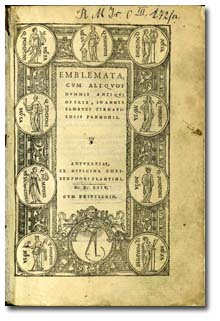 A
number of albi amicorum includes only handwritten mementos.
These are occasionally accompanied by designs or – especially in
earlier centuries – painted coats of arms. However, the album
amicorum can be also a printed book, in many cases an emblem book.
The emblem, a sign or symbol referring to its possessor, in most cases
a design, a woodcut or a copperplate, is usually accompanied by a
short epigram. The various emblemata are collections of such
emblems. A
number of albi amicorum includes only handwritten mementos.
These are occasionally accompanied by designs or – especially in
earlier centuries – painted coats of arms. However, the album
amicorum can be also a printed book, in many cases an emblem book.
The emblem, a sign or symbol referring to its possessor, in most cases
a design, a woodcut or a copperplate, is usually accompanied by a
short epigram. The various emblemata are collections of such
emblems.
The most renowned Hungarian emblemata was composed by the
physician, philologist and historian János Zsámboky (with his Humanist
name Joannes Sambucus, 1531-1584): Emblemata cum aliquot nummis antiqui operis, Ioannis
Sambuci Tirnaviensis Pannonii. Antverpiae, Ch. Plantin 1564. A
copy of this emblem book conserved in the Library of the Hungarian
Academy of Sciences (RMK III 172a) is beautifully bound in leather
with gilt and gauffered edge. It came to us together with the family
library of Count József Teleki, founder of our Library. The uniqueness
of this copy is due to the interleaved pages with painted coats of
arms and concomitant notes. The great success of Sambucus' emblem book
is demonstrated by its five editions as well as by its being
translated into French and Dutch.
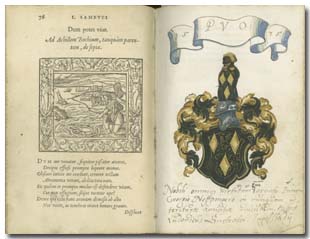
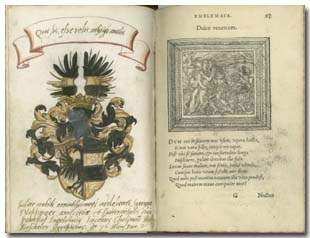
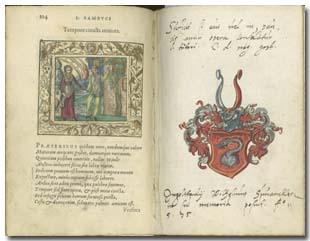
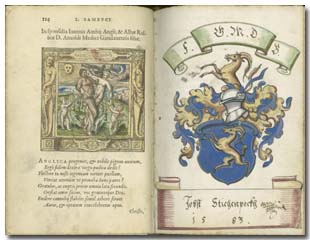
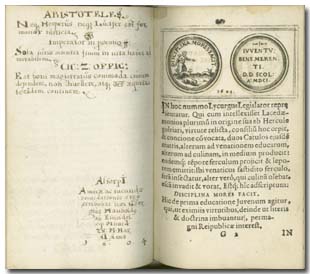 The
volume with the call-number 524.971 of our library includes three
works bound together. The first two of these are emblem books. The
first one has the title Epitome emblematum
panegyricorum Academiae Altorfinae.
Studiosae iuventuti proposita, Nürnberg
1602. This emblem book was first published by its author Levinus The
volume with the call-number 524.971 of our library includes three
works bound together. The first two of these are emblem books. The
first one has the title Epitome emblematum
panegyricorum Academiae Altorfinae.
Studiosae iuventuti proposita, Nürnberg
1602. This emblem book was first published by its author Levinus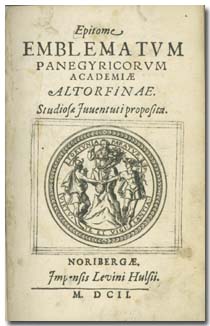 Hulsius
on his own costs in 1597 in Nürnberg. It includes the designs of the
medals awarded to winners of various literary competitions at the
nearby Academy of Altdorf, accompanied by explanatory and laudatory
texts. This second edition of the work was bound with interleaved
pages that bear handwritten mementos, mostly by students of Altdorf. Hulsius
on his own costs in 1597 in Nürnberg. It includes the designs of the
medals awarded to winners of various literary competitions at the
nearby Academy of Altdorf, accompanied by explanatory and laudatory
texts. This second edition of the work was bound with interleaved
pages that bear handwritten mementos, mostly by students of Altdorf.
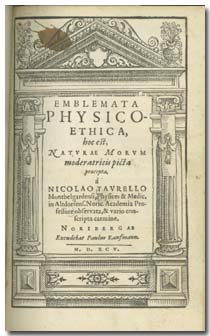 The
second work in this volume is an emblem book by Nicolaus
Taurellus: Emblemata physico- ethica, hoc est, naturae morum
moderatricis picta praecepta, Noribergae, Paulus Kaufmann, 1595.
The emblems in this book, also published in Nürnberg some years
earlier than Hulsius', apart from offering symbolic illustrations of
various concepts, also include small coats of arms, accompanied by
Latin epigrams. Every page printed with emblem and epigram has a
facing page printed with a decorative border, but otherwise left blank
for handwritten mementos. On pp. 12-13. for example we can read the
same family name (Gugel) The
second work in this volume is an emblem book by Nicolaus
Taurellus: Emblemata physico- ethica, hoc est, naturae morum
moderatricis picta praecepta, Noribergae, Paulus Kaufmann, 1595.
The emblems in this book, also published in Nürnberg some years
earlier than Hulsius', apart from offering symbolic illustrations of
various concepts, also include small coats of arms, accompanied by
Latin epigrams. Every page printed with emblem and epigram has a
facing page printed with a decorative border, but otherwise left blank
for handwritten mementos. On pp. 12-13. for example we can read the
same family name (Gugel)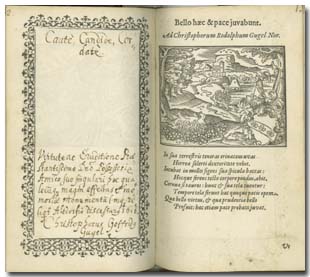 printed above the emblem on the right side, and written by hand under
the memento on the left side. Pp. 52. and 126. both include the same
popular motto "Non est mortale quod opto" used by
Sámuel Fáy in the album of Ferenc Páriz Pápai. So this colligate
volume is also a special type of the genre of albi amicorum. –
This volume got in the possession of Count Tódor Batthyány, and it
came together with the library of the Batthyány family to our Library.
printed above the emblem on the right side, and written by hand under
the memento on the left side. Pp. 52. and 126. both include the same
popular motto "Non est mortale quod opto" used by
Sámuel Fáy in the album of Ferenc Páriz Pápai. So this colligate
volume is also a special type of the genre of albi amicorum. –
This volume got in the possession of Count Tódor Batthyány, and it
came together with the library of the Batthyány family to our Library.
Levinus Hulsius was born in Ghent, in the Netherlands, and won fame as
a geographer. He was a professor of French in Nürnberg. He also wrote
a work relating to Hungary:
Chronologia Pannoniae. Eine kurtze Beschreibung des Königreichs Ungern,
Nürnberg 1595, that was published two more times in the two following
years, and he also visited Hungary. –
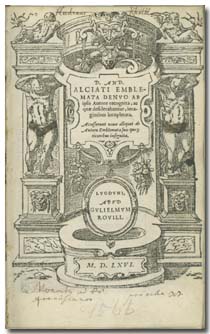 Nicolaus
Taurellus was born in Mömpelgard; he graduated in philosophy and
medicine, and was a professor of this latter science at the University
of Altdorf. Nicolaus
Taurellus was born in Mömpelgard; he graduated in philosophy and
medicine, and was a professor of this latter science at the University
of Altdorf.
The name of Andrea Alciato, the celebrated jurist of his age is today
most known by his Emblemata. Our Library conserves several
editions of this influential work, published in more than 150 editions
between 1531 and the end of the 18th century. Two of our copies were
bound in French Renaissance gilded leather binding at the middle of
the 16th century, at the same time of the publication of the
respective editions. The one published in 1551 in Lyons
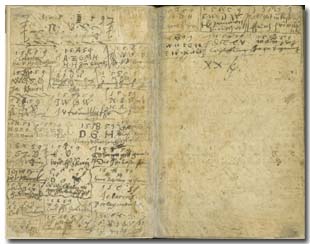 (call-number:
542.344) includes short mementos on the blank flying-leaves at the
beginning and the end of the book. The other (542.328), published in
1566 also in Lyons, includes interleaved pages between each two
printed pages, which, however, were left blank. It is to be supposed
that this latter copy was bound with interleaved blank pages by the
editor itself, and was sold professedly for the purpose of album
amicorum. So it bears a testimony to the fashion of this custom
that has survived many centuries. – (call-number:
542.344) includes short mementos on the blank flying-leaves at the
beginning and the end of the book. The other (542.328), published in
1566 also in Lyons, includes interleaved pages between each two
printed pages, which, however, were left blank. It is to be supposed
that this latter copy was bound with interleaved blank pages by the
editor itself, and was sold professedly for the purpose of album
amicorum. So it bears a testimony to the fashion of this custom
that has survived many centuries. –
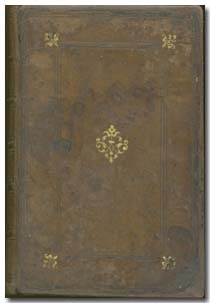 It
is also interesting to mention that p. 355. of the album of Ferenc
Páriz Pápai also includes a motto borrowed from the obviously very
popular emblem book of Alciato, noted by
János Patai on August 22, 1713 in Halle. It
is also interesting to mention that p. 355. of the album of Ferenc
Páriz Pápai also includes a motto borrowed from the obviously very
popular emblem book of Alciato, noted by
János Patai on August 22, 1713 in Halle.
The second memento in the album of
Pápai Páriz, on p. 9. was noted by
Count Miklós Bethlen. The biblical text quoted
by him bears a close parallel to the text of the dedication: "…we must
through much tribulation enter into the kingdom of God – experiencing
this on himself, being endowed with many worldly honours and deprived
of the same, this was noted by Miklós Bethlen, called by vain title a
Count, in the 1711th year of the Lord's birth, the seventieth of his
life, and the eighth of his captivity … in Vienna." The memento
noted in Latin verse by Kaposi Sámuel for the
young Pápai
Páriz setting out to foreign academies is also very considerable and
timely: "…Come home, this is my supreme advice."
The album
of Ferenc Pápai Páriz Jr.
The Department of Manuscripts and Rare Books of the Library of the
Hungarian Academy of Sciences conserves the album amicorum of
Ferenc Pápai Páriz Jr. (call-number: Tört.
Napló kis 8o 6). 1
This album includes notes in Latin, Greek, Hebrew, Arabic, Syriac,
English, German, French, Italian, Spanish and Provençal. This album
was taken by Ferenc Pápai Páriz Jr. to his
peregrination between 1711 and 1726 from Kolozsvár to Oxford, when
visiting the Protestant universities of Europe, and asked mementos of
his professors, famous scholars and his fellow students. Pápai Páriz
had also another mission: he had to raise funds for the College of
Nagyenyed (Aiud) repeatedly burnt down by
Austrian troops (1704 and 1707). The album of Pápai Páriz includes no
designs and coats of arms, but its notes are very various and rich,
informative and edifying, and in many cases they have the value of
primary sources.
His father, the professor of the College of Nagyenyed, Ferenc Pápai
Páriz Sen., whose bulky Latin dictionary has been used by us several
times during the preparation of this web edition, had graduated in
medicine on Swiss and German universities. He was the court physician
of both Princes of Transylvania Mihály I. and II. Apafi. The album
includes notes of thirty-seven Hungarian personalities, amongst the
first of Mihály II. Apafi living in Vienna,
dated on September 23, 1711. Ferenc Pápai Páriz
Sen. wrote his note to his son setting out to road on p. 447 in
Latin, Greek, Italian and Provençal, but not in Hungarian. Apart from
Hungarian family names we find no Hungarian word in the album. The
identity of the Hungarian personalities is also rather important for
the history of sciences in Hungary, although it is not always easy to
decide their national identity. For example, are Georg Sigismund Liebezeit
from Sopron, or the Saxon
Tobias Stranover who later put roots in
England, to be regarded as Hungarians? They certainly regarded
themselves as hungarus, and their common language was Latin, as
it was generally so between the educated in the whole Hungarian
Kingdom, with no regard to national identity. The case was similar to
that of a number of Swiss and German scholars, as well as French
Huguenots who had fled to the Netherlands, and became there renowned
professors, pastors or physicians, but their descendants already
became Flemings or Vallons. The Prussian Wilke opted for England, and
he also assimilated his name to his chosen homeland: he noted in the
album as Wilkins. Europe was already a
universal home for the citizens of all European countries. Certainly,
every educated person, but in many cases and to a certain extent also
the journeymen setting out to abroad to practice and perfectionate
their crafts did speak Latin.
The
structure of the notes in the album
The notes usually begin with a shorter or larger quotation, in many
cases from the Bible or well known ancient authors. Besides this, a
motto or "symbolum" is also often included. The dedications written to
Ferenc Páriz Pápai are in some cases conventional, in other cases very
personal, and his father is in several cases also mentioned, as many
old foreigner professors had still known him personally. Apart from
one anonymous note, every memento is signed, to which in most cases
the offices and titles of the persons are also added. The date (year,
month, day) and place are usually also included, this latter
regularly in Latin version (for example Ratisbona for Regensburg, Tig.
Helv. Metrop. for Zürich, Lugduni Batavorum for Leiden, Trajecti ad
Rhenum for Utrecht, or Oxon. for Oxford).
Dating and
calendars
The Catholic countries of Europe adopted the Gregorian calendar in
1582, but the Protestant regions did so only much later, and in
various dates (some parts of Switzerland only in 1812). In Hungary
there were "veterists" as well who firmly adhered to the "old
calendar", and printed calendars continued to simultaneously indicate
the dates according to the old calendar (stilo veteri) and to the new
one (stilo novo) for long decades even after the adoption of the
Gregorian reform. England kept the Julian calendar as long as
until 1752, and the year begun on March 1, instead of January 1. This is why
some, at least foreigners, use a double dating, as we can see in a
letter by Ferenc Pápai Páriz: "Londini 14 st. v. / 25 st. n. Xbris
[=Decembris] 1715", and in his album: "1718/19 Feb. 1". – In our web
edition the English datings, if they were with certainty according to
the "old style", have been recalculated to our modern calendar.
Some
statistics
As to their citizenship, we have mementos of 8 Hungarian, 29
Transylvanian, 31 German, 15 Englishmen, 14 Dutchmen, 12 Swissmen, 3-3
Frenchmen and Polish, one Danish and two personalities of unknown
origin, apart from the possessors themselves. It is not easy to
categorize them according to their professions, for some of them
simultaneously provided for the offices of physician, theologian and
pastor. We have 19 VDM (= verbi divini ministers, "servants of the
divine word"), that is, pastors, 17 professors of theology, 16
students of theology, six bishops, ten professors of philosophy and
philology, four students of philology, ten noblemen of high rank or
high officers, (for example the Prince of Transylvania
Mihály II. Apafi, or
Count Miklós Bethlen, and their secretaries),
five professors of medicine, eight students of medicine, three
physicians, two professors of law, three students of law, four scholars
of natural history (including Newton and
Halley), one painter (Tobias Stranover),
two schoolboys (a young Count Teleki, Mihály
and the younger brother of Ferenc Páriz Pápai,
András). Eight persons did not indicate their
profession.
Almost a third of the mottos come from the Bible (46), but not much
less are taken from popular proverbial wisdom (41). Classical authors
are also represented with a high number (32). About a tenth of the
notes (15) include a poem written by the author of the memento himself. The
quotations from church fathers and from "modern" – 16-17th century –
authors are equally 5.
Concerning the language of the mementos, all the authors wrote
something in Latin, at least some words connected to their signature.
78 persons wrote only in Latin, 25 in Greek, 5 in Hebrew, 2 in
Italian, and one-one in English, Arabic, Provençal, Spanish and
Syriac. Five persons wrote their mementos in two or more languages in
addition to Latin.
The binding
of the album
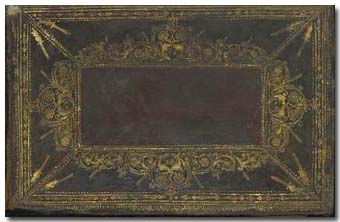 The album
is bound in a dark brown Baroque leather binding tooled in gold.
Designs of the upper and lower cover are identical. Covers are
bordered with an ornament of small arches. Within this runs a roll of
small flowers and gems limited by a double line from the outside and a
line and a pointed line from the inside. The centre is covered by a
red leather onlay, meant probably for a name or a title, but left void
on both the upper and the lower cover. The corners of this are linked
by diagonals to the outer frame. The diagonals are flanked each by a
pair of flowers with long pistils. The central rectangular onlay is
surrounded by typical floral curls twisting to the right and to the
left, respectively. The spine has two bands and three compartments,
with the inscription FRANC // PARIZ // PAPAI // 1707 in the central
one. The upper and lower compartments are decorated with three flowers
each. The binding was made in Transylvania, perhaps in Kolozsvár
(Cluj), or possibly in Debrecen. The album has marbled end-leaves and
red and white headbands, and gilt and gauffered edges. Its size is an
oblong 106 × 158 × 38 mm. The first quire consists of three pairs of
leaves, but the half of the central leafs was cut off. Some other
leaves were cut out later, too, perhaps by Pápai Páriz himself, maybe
in order to write and hand a note to somebody. The other quires
consist of four pairs of leaves. The pages were later numbered by
hand. Today the numbering runs to 477, including the inner side of the
back end-leaf, on which György Rettegi made his note. There are some
erroneous numbers between pages 75 and 80. Number 75 figures twice,
while one leaf in the middle of the book, as well as the first leaf
were left unnumbered. The album
is bound in a dark brown Baroque leather binding tooled in gold.
Designs of the upper and lower cover are identical. Covers are
bordered with an ornament of small arches. Within this runs a roll of
small flowers and gems limited by a double line from the outside and a
line and a pointed line from the inside. The centre is covered by a
red leather onlay, meant probably for a name or a title, but left void
on both the upper and the lower cover. The corners of this are linked
by diagonals to the outer frame. The diagonals are flanked each by a
pair of flowers with long pistils. The central rectangular onlay is
surrounded by typical floral curls twisting to the right and to the
left, respectively. The spine has two bands and three compartments,
with the inscription FRANC // PARIZ // PAPAI // 1707 in the central
one. The upper and lower compartments are decorated with three flowers
each. The binding was made in Transylvania, perhaps in Kolozsvár
(Cluj), or possibly in Debrecen. The album has marbled end-leaves and
red and white headbands, and gilt and gauffered edges. Its size is an
oblong 106 × 158 × 38 mm. The first quire consists of three pairs of
leaves, but the half of the central leafs was cut off. Some other
leaves were cut out later, too, perhaps by Pápai Páriz himself, maybe
in order to write and hand a note to somebody. The other quires
consist of four pairs of leaves. The pages were later numbered by
hand. Today the numbering runs to 477, including the inner side of the
back end-leaf, on which György Rettegi made his note. There are some
erroneous numbers between pages 75 and 80. Number 75 figures twice,
while one leaf in the middle of the book, as well as the first leaf
were left unnumbered.
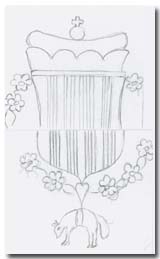 We have not
corrected these errors. Today the album includes 240 leaves, with 121
written pages. It has no title page, and does not contain drawings. We have not
corrected these errors. Today the album includes 240 leaves, with 121
written pages. It has no title page, and does not contain drawings.
The watermark of the paper (on the blank pages 205 and 207) is a
shield with longitudinal sections, a crown and cross on the top,
flowers around the shield, and the sheep of the golden fleece hanging
under it. This design is very similar to the shields no. 386 and 391
included in the watermark catalogue composed in the form of artistic
drawings by Nándor Lajos Várkonyi, copied from archival material in
the Museum of Sepsiszentgyörgy (Sfîntul Gheorghe). 2
The dating of the first document is April 25, 1708, while of the
second December 20, 1711; this latter was conserved in the epistolary
of the Transylvanian Vaja family. All these details coincide with the
period of preparation and original place of use of the album of Ferenc
Páriz Pápai.
The provenance of the album
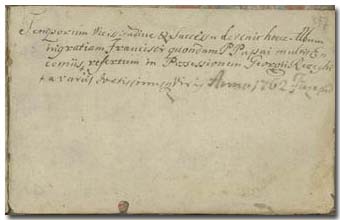 The
inner part of the back endleaf bears a note of
György Rettegi (1718-1786). Erzsébet Diószegi,
the mother of the first wife of Rettegi, Salome Aczél, was married as
a widow by Ferenc Pápai Páriz Jr. The children born in this matrimony
died at an early age. The Latin memento of Rettegi informs us
that "through the adversities of times and of good fortune this album
of the late Ferenc Pápai Páriz, full of laudations by various erudite
men, came into the possession of György Rettegi in 1762". The
inner part of the back endleaf bears a note of
György Rettegi (1718-1786). Erzsébet Diószegi,
the mother of the first wife of Rettegi, Salome Aczél, was married as
a widow by Ferenc Pápai Páriz Jr. The children born in this matrimony
died at an early age. The Latin memento of Rettegi informs us
that "through the adversities of times and of good fortune this album
of the late Ferenc Pápai Páriz, full of laudations by various erudite
men, came into the possession of György Rettegi in 1762".
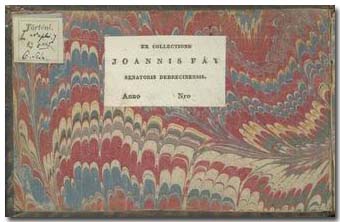 A
simple
ex
libris is stuck to the inner side of the upper cover of the album,
according to which it came to the collection of the Senator and later
Mayor of Debrecen János Fáy (1773-1833). 3
The renowned collection of János Fáy of Fáj was admired by many
outstanding personalities of the period, including the writer and
leading literary critic Ferenc Kazinczy, a relative of him. His mother
was Mária Terézia Klimó, younger sister of the Bishop of Pécs György
Klimó. Apart of his famous collection of paintings, the old Hungarian
prints of his library had an exceptional value. His collection
included more than one album amicorum: these were also seen by
Kazinczy 4 who copied
several mementos for himself. From this album he mentions by name
Newton, Prince Mihály II. Apafi, Count Sándor Teleki, and Count Miklós
Bethlen. János Fáy died without children, and he appointed his heir
his nephew Alajos Fáy. A
simple
ex
libris is stuck to the inner side of the upper cover of the album,
according to which it came to the collection of the Senator and later
Mayor of Debrecen János Fáy (1773-1833). 3
The renowned collection of János Fáy of Fáj was admired by many
outstanding personalities of the period, including the writer and
leading literary critic Ferenc Kazinczy, a relative of him. His mother
was Mária Terézia Klimó, younger sister of the Bishop of Pécs György
Klimó. Apart of his famous collection of paintings, the old Hungarian
prints of his library had an exceptional value. His collection
included more than one album amicorum: these were also seen by
Kazinczy 4 who copied
several mementos for himself. From this album he mentions by name
Newton, Prince Mihály II. Apafi, Count Sándor Teleki, and Count Miklós
Bethlen. János Fáy died without children, and he appointed his heir
his nephew Alajos Fáy.
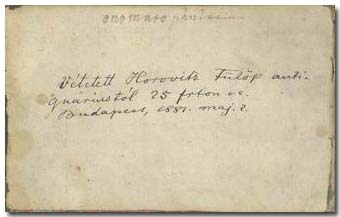 The
note on the inner side of the flying leaf at
the beginning of the album informs us that it was "purchased from the
antiquarian Fülöp Horovitz for 25 forints in Budapest, May 2, 1881".
This note is probably the hand of Ernő Lindner, sub-librarian of
the Academy. The album of Ferenc Pápai Páriz was registered in the
Receipt Inventory of the Department of Manuscripts of the Library of
the Academy by Elek Jakab as the first item in 1881. 5 The
note on the inner side of the flying leaf at
the beginning of the album informs us that it was "purchased from the
antiquarian Fülöp Horovitz for 25 forints in Budapest, May 2, 1881".
This note is probably the hand of Ernő Lindner, sub-librarian of
the Academy. The album of Ferenc Pápai Páriz was registered in the
Receipt Inventory of the Department of Manuscripts of the Library of
the Academy by Elek Jakab as the first item in 1881. 5
Fülöp
Horovitz (1815-1886) was graduated in medicine, and worked in a
hospital between 1849 and 1851. He was, however, much more interested
in books. Already in 1847 he wanted to open an antiquary, and this
intention of his was supported, amongst other, by the leading writers
and literary critics József Bajza,
János Erdélyi, György Fejér and Ferenc Toldy. He became the manager of
the Fischer bookshop, then in 1852 he purchased the shop and began to
develop it. He was generally respected for his expertise and the
knowledge of the sources of old literature. His bookstore was sold out
in 1884.
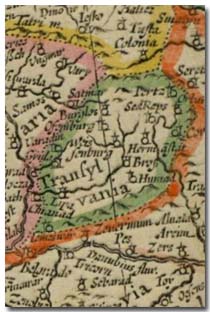 Peregrination Peregrination
Peregrination, as we intend it here, does not refer to religious
pilgrimage, but to the long travel undertaken by students to foreign
universities, that was also general amongst Hungarian students.
Catholic youth could go to nearby universities, like Vienna, Graz and
Cracow, or to the Academy of Nagyszombat (Trnava). However, Protestant
students intending to graduate had to go farther. Transylvanian
Calvinist students were especially well represented in the academies
of Germany, Switzerland and the Netherlands, and many of them also
visited the universities of England. A remarkable fact is for example
that in the university of Franeker, an important centre of
Reformation, in the 17th century the greatest number of foreign
students came from Hungary, primarily from Transylvania. This was also
due to the fact that Calvinists, whose proportion was especially high
in Transylvania, could not find adequately high level academic
training at home.
Thus Hungary, amongst other through his Hungarian students,
was an organic part of the intellectual blood circulation
of Europe, of which she became a member by full right again
on May 1, 2004.
|